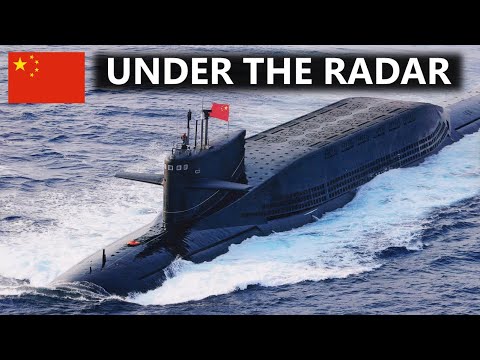How Strong is the Submarine Force of the Chinese Navy?

while the modernization of the chinese navy's surface warships has attracted a great deal of attention the progress made in modernizing china's submarine forces has been fairly under-appreciated most of its active submarines are now at a competitive modern standard that said a fair number of old submarines remain in service which means that there is a substantial variation in quality across the entire submarine force here are three simplified submarine classifications that i'm going to use they are shorthand symbols for each submarine type to facilitate brevity ssn represents nuclear-powered attack submarines while ssbn stands for nuclear-powered ballistic missile subs ssk means diesel-electric attack submarines which are conventionally powered there are more specific classifications for different types of SSKs for example whether or not they have air independence propulsion but i'm not going to do that here the majority of china's submarines are conventional SSKs designed for the defense of the near seas with limited force projection capacity but there is also a sizeable force of nuclear-powered attack submarines the third largest after russia and the united states china also has nuclear ballistic missile subs contributing to its nuclear deterrence the mainstream opinion is that the main weakness of the pla navy submarine force is nuclear submarines which remain noisier than their u.s counterparts but the latest chinese ssn and ssbn are catching up at a steady pace meanwhile china's strength lies in its conventional submarines which are on the whole very capable and stealthy the total number of chinese submarines in service is estimated as between 70 to 80. the pla navy does not disclose how many submarines it has unlike the u.s and the russian navies when it comes to the size of the chinese submarine force
the best one can say with a straight face is to give a range in terms of the number that may exist chinese submarine numbers should continue to grow over the coming years but the growth is likely to be slower than surface warships the pla navy prioritizes the production of new submarines with a focus on nuclear subs but will also decommission old units that fall short of the required modern standard so while the number of submarines will grow only slowly as old units are replaced the improvements in the capability of the submarine force as a whole should be in excess of their mere numbers we will start by looking at the ssns of which there is about a dozen all nuclear powered submarines were built at the Bohai shipyard at Huludao located in the Liaoning province that borders north korea the mainstay of the chinese ssn force is the type 93 and the improved versions the type 93a and the type 93g the nato classification for this family of submarines is the shang class there are two boats of the original type 93 design which were built between 1998 and 2003. chinese sources generally assess that their noise level is on par with the russian akula class and the u.s navy's improved los angeles class in contrast u.s naval intelligence is far more dismissive claiming that the original shang class is noisier than the soviets union's victor 3 class built in the 1980s there are two improved versions of the shang class the type 93a and the 93g there are between 2 to 4 boats of the type 93a variant the type 93a is considered to be much quieter than the original shang class because of new technology for example western observers believe that the nuclear reactor's cooling system has become more silent reflecting progress in chinese domestic nuclear industry most u.s experts have come to view the type 93a as on the same noise level as the improved los angeles class which currently represents about half of the u.s navy submarine force the type 93a is believed to have a shelter holding a miniature submarine for inserting special operations forces to raid lightly defended islands or coastlines there are probably three of the type 93g submarines the most prominent feature of this variant is a dozen vertical launch cells which can fire the yj18 supersonic anti-ship cruise missile and the cj-10 land attack missile the addition of these missile cells on board the type 93g will have substantially increased their offensive capability so to summarize the shang class is the frontline ssn of the chinese navy the improved versions of this class are generally considered to be as stealthy as some of the u.s navy ssns although still noisier than the latest virginia class
the type 91 which has the nato classification the han class is china's first generation ssn the first unit was introduced in 1974. the type 91 has faced a multitude of problems including high noise levels the type 91 was detected during several incidents in the past where the chinese navy probably didn't want to reveal the submarine's presence for example a type 91 it is in shadowed the u.s carrier the kitty hawk in the yellow sea in 1994 but was detected by the u.s carrier group which tracked the submarine using sonar buoys over the course of three days however the type 91 has received many upgrades over the years including the installation of anechoic rubber tiles which help to reduce noise the weapon systems were also improved including new sonars naval mines and cruise missiles three type 91 ssns remain in service although probably in a reserve role they are expected to be decommissioned very soon the pla navy is constructing a new class of type 95 ssn that should be quieter and better armed than preceding classes each iteration of chinese ssn had consistently led to a major advancement in terms of quality so it would be incorrect i think to draw any conclusion based on current designs the successful development of the type 95 would go a long way towards closing the gap with major western navies in terms of the quality of nuclear-powered attack submarines china maintains a fleet of 7 to 8 nuclear ballistic missile submarines and one experimental conventional ballistic missile submarine china's undersea nuclear deterrence is based around the type 94 ssbn which is named the Jin class by nato the type 94 is divided into two variants the basic type 94 that was introduced in 2004 and the improved type 94a seen for the first time in 2016. according to
u.s naval intelligence the four original type 94 submarines are at a similar noise level as the russian delta 3 ssbn introduced in 1976 domestic chinese sources also rated them as quite loud like other chinese nuclear submarines from the early 2000s the Jin class is probably quite noisy indeed which affects their suitability for nuclear deterrence patrols the type 94 has 12 missile tubes to carry the jl-2 submarine launched nuclear ballistic missiles if launched from the safety of chinese waters the jl-2 does not have the range to threaten continental united states but still poses a credible nuclear deterrence to other nuclear-armed states in the asia-pacific region there are between three to four of the improved type 94-a which addresses some of the weakness of the original design this variant is believed to have improved hydrodynamics which should reduce fluid noise and better sonars more importantly the type 94a is likely to carry a new ballistic missile the jl-2a which has a range of 11 thousand and 200 kilometers far greater than the basic jl-2 if launched from the safety of chinese naval bases the jl-2a has the range to reach the western united states this means that the type 94a provides a far more credible second strike capability than the original type 94 ssbn china is developing the type 96 ssbn a key objective of this project is to heavily reduce the noise levels and improve stealth capabilities compared to the type 94 such that the type 96 can undertake deterrence patrols without being detected another objective is the integration of the new jl-3 submarine-launched ballistic missile that is being developed the jl-3 ballistic missile will have even greater range than the jl-2a aside from the nuclear-powered SSBNs china also operates a single conventional ballistic missile submarine the type 32 it is the largest diesel electric submarine in the world with a submerged displacement of 6 thousand and 600 tons the type 32 is a test submarine with just two or three ballistic missile tubes it is intended to test ballistic missiles and may also test other technologies for example escape pods torpedoes and cruise missiles it is cheaper to do ballistic missile tests on a dedicated non-nuclear submarine than it says to build a nuclear boat for that purpose that said in a wartime emergency the type 32 may be fitted with real nuclear warheads to increase the readiness of china's nuclear forces if you enjoyed this video so far please press like and subscribe if you feel especially generous you can consider becoming a patreon supporter at patreon.com eurasia naval insights which is in the video description we have discussed mainly nuclear-powered submarines from here we will be moving onto conventional attack subs and this is really the main strength of the pla sub reinforce now there are plenty of misunderstandings about the capability of diesel submarines including claims that they are noisier than nuclear-powered submarines this is not just regarding chinese submarines people have been dismissive of the japanese diesel subs that i covered in previous videos it is important to know that diesel electric submarines do not use their diesel engines to travel underwater they use their diesel power plants to recharge their batteries on the surface and use battery power to propel an electric motor to move underwater a modern diesel submarine on battery power is actually very quiet the best class of conventional submarines in the chinese navy are the type 39a and b and the type 39c these are collectively termed the yuan class by nato there are about 20 of them the yuan class and all of its derivatives feature air independence propulsion or aip for short aip is an extra power plant that does not require the submarine to surface or snorkel in order to run this means that a submarine with aip can remain submerged for far longer but at the cost of traveling much slower underwater than on battery power the pla navy actually operates the largest number of aip capable submarines in the world unlike many of the diesel submarine classes of other navies the yuan class has a comprehensive suite of sonars including a low frequency passive flank array sonar the hsqg 207 which is intended to provide long range detection in deep waters because of this and the aip some western and chinese experts assist that the yuan class is partially designed for open ocean deployments beyond coastal waters this basically bucks the established wisdom where modern diesel boats are used mainly for coastal defense the yuan class incorporates designs that reduce noise levels including fluid and propeller noise this is regarded as very stealthy and capable and comparable to the advanced diesel electric submarines of countries such as japan and sweden the most recent variant the type 39c has a distinctively angled sail which resembles the stealth features found on stealth aircraft the design should make the submarine more stealthy to radars when traveling on the surface for example when entering or leaving busy ports or naval bases greater radar stealth suggest more of an emphasis on surface operations for example the insertion of special forces there is also speculation that the type 39c is equipped with lithium-ion batteries which store substantially more energy than traditional lead acid batteries if true this would massively increase the submarine's submerged endurance and performance next we move on to the traditional diesel electric submarines those without aip we have 13 of the type 39 SSKs or the song class this is a fairly basic diesel attack boat the song class is one of the older chinese submarine classes but they are still fairly modern introduced around 1998 they remain reasonably stealthy and capable the type 39 is suitable for coastal defense although without aip they cannot be expected to operate too far from friendly bases because they need to surface or snorkel to recharge their batteries there are 10 of the improved kilo submarines purchased from russia between 1997 and 2005 they are comparable to the song class although with less effective passive sonars owing to the lack of a flank sonar array unless the chinese navy had done wholesale modernization to the kilo in the two decades after the cold war the improved kilo class maintained a reputation for being extremely silent and stealthy and has been given the nickname the black hole by nato submariners they remain a potent asset for coastal defense despite the passage of time also in service is the much older type 35 ming class the ones that remain in service were built in the 1980s and the 1990s they are a modernized version of the soviets designed romeo submarines from the late 1960s while they have been upgraded over the years they are nevertheless outdated by modern standards the type 35 ming class is in the process of being phased out a few boats have been sold or otherwise provided to countries friendly to beijing two boats were purchased by bangladesh and one boat was transferred to myanmar on the 8th of february 2022 a video was leaked onto chinese social media of a new type of small and presumably conventional submarine the boat was filmed cruising the yancey river the sighting prompted further speculation that the chinese navy was close to operationalizing lithium-ion batteries which would massively increase energy storage and allow for more powerful and power-hungry sonars to be installed if true this would increase substantially the combat utility of small submarines however this is merely speculation and we just have to wait and see in conclusion china is modernizing its submarine force and this effort has often gone under the radar compared to the buildup of surface warships china's focus is on improving the quality of its submarines rather than the number with new boats generally replacing the old ones presently the chinese nuclear submarine force is still a fair way behind the u.s navy but the chinese navy has narrowed the gap over the past decade and should catch up even more going forward meanwhile china has maintained a strong position in conventional submarines in terms of both quantity and quality if you would like to learn more about chinese submarines you could start with the type 93 shang class ssn you should be able to see a video reviewing the shang class on your screen right about now
2022-04-25 17:34


